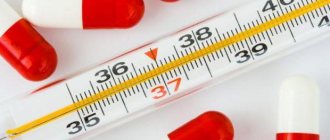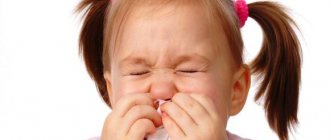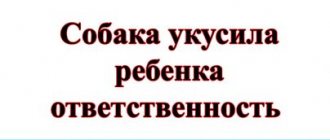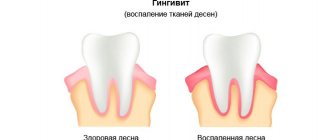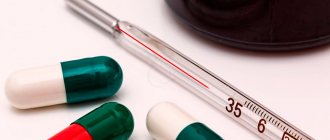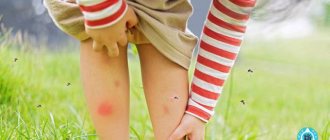Why does the temperature rise
If the thermometer is creeping up, then the first thought is that the baby is sick. Temperature is the baby's protection. Detecting a foreign invasion, the child’s body itself begins to fight it. In order for the substances that kill the infection to begin to be released, heat is necessary. In addition, the heat prevents germs and viruses from multiplying.
But this is not always the case; it happens that the little one is simply overheated or too excited. Thermometry readings in young children may be unstable. For example, at 1 month, even after actively crying, the baby can give 37.5. While at 4 months the first growing tooth may develop a fever. So, the causes of fever:
- Overheat. In a 6-month-old baby, thermoregulation is no longer so vulnerable, but still very delicate. That is why you should not let your baby overheat in a stuffy car or in direct sunlight. Wrapping yourself up too warmly is unfavorable. Synthetic clothing is completely unacceptable - although it is bright, beautiful, and easy to wash, it does not allow the skin to breathe.
- Graft. In a child of the first year of life, fever can be observed after vaccination. The temperature can last for about three days.
- Stress. A child develops a fever even from experienced stress, excess emotions or new impressions. Moreover, the indicator can reach 38 degrees.
- Allergy. This is another reason to give your child a fever. Sometimes allergies are difficult to distinguish from a cold or virus. Just as in the case of an infection, the nose may become stuffy, sneezing and coughing may begin, and the throat may become red. Only a doctor can help you figure out what comes your way: an allergy or an infection.
- Bacteria and viruses. The most common cause of fever in a child is an infection. “Favorite” childhood infections are respiratory and intestinal. From 5 months, intestinal infections become more and more likely, because new products appear in the baby’s food, and more and more new objects enter the toddler’s mouth for study.
Important! If you suspect an infection, seek medical help immediately! You should not come up with a diagnosis and treatment for children on your own. This is a dangerous activity that can affect the entire subsequent life of a little person.
What should you never do if you have a fever in children?
When bringing down a child's fever, parents should know that there are actions that are unacceptable under any circumstances. And no matter what grandparents say, referring to their life experience, you can never :
• wipe the child's body with vinegar or alcohol solutions. These actions may cause more trouble than good. Poisoning with acetic acid or alcohol will also be added to the general malaise; • apply ice or other very cold objects to the skin of a person with a fever. At this time, the skin temperature may drop, but the temperature of the internal organs will reach dangerous critical values; • use a cold wet sheet, cold rubbing - this is fraught with the same vascular spasm; • use aspirin and drugs containing it. It can cause Reye's syndrome in a child, a state of confusion accompanied by vomiting and intestinal upset.
Even if the temperature was successfully brought down, the child will have to be monitored for some time. It is possible that the temperature will rise again over time. Then it would be best to consult a doctor who will help determine the cause of the fever, prescribe appropriate treatment and help restore the child’s health after a high fever.
What temperature should be reduced
When can measures be taken to lower the thermometer readings? A fever of up to 38 degrees is not dangerous for a 6-month-old baby. Parents should monitor the well-being of their child. If the baby plays, drinks water, does not show apathy and is not capricious, then it is quite possible to wait.
Remember! The heat of 41 degrees is life-threatening. Under no circumstances should you reach this figure. If you can’t lower the temperature on your own, call an ambulance. At such a tender age, the process easily gets out of control.
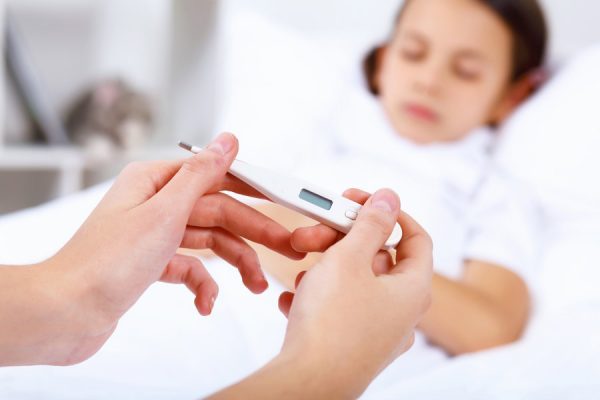
There is a general rule: children under six months old can bring down a temperature that has reached 37.9 or 38 degrees. But if the baby is clearly not feeling well, then measures should be taken. It is also necessary to bring down the temperature for those who have a history of febrile convulsions, heart and vascular diseases, and nervous disorders. For these children, already at 37.8, measures must be taken.
How to reduce a child's fever
You and I have agreed on the conditions under which we will lower the temperature.
And here are instructions on how to do this effectively and safely. Proceed step by step.
My beloved best friend, I introduced point number 0 especially for you.
IT IS ABSOLUTELY IMPOSSIBLE TO GIVE ASPIRIN TO CHILDREN!!!!
IT IS ABSOLUTELY IMPOSSIBLE TO GIVE CHILDREN THE LYTIC MIXTURE OR ITS INDIVIDUAL COMPONENTS: ANALGIN, DIMEDROL, PAPAVERINE!!!!
This is life-threatening!!!!!
Now that we know exactly what not to do, let's remember what can and should be done.
ATTENTION!!! Up to 2 years of age, a temperature above 39.5 requires an immediate call to the ambulance!
High temperature - what to do
The thermometer reading is too high - we begin to act. Is it possible to do without drugs?
- The first thing to do to reduce fever is to undress the little one. Clothes and diapers create a “bath”, from which the temperature only rises.
- If your child has icy hands and feet, this means that a spasm of peripheral vessels has occurred. Don't panic, this is a natural reaction of the body that fights against unfavorable factors. Warm your hands, or just give your baby drotaverine (no-shpu).
- Do a rubdown. Not all children like this procedure; be prepared for protest and indignation. To reduce discomfort, pour water at least 37 degrees. No alcohol, vodka or vinegar (if you want to avoid burns, poisoning, sudden allergies)! Only clean water! Take a soft natural towel, soak it in water and wet your son or daughter’s skin using dipping movements. Droplets of water should remain and dry themselves. Do this procedure at least 5 times. After the procedure, wear thin, non-parka natural clothing. Rubbing will not immediately relieve the fever, but it will drop by 1 degree in about half an hour. This is already a big help for the little one.
- Water! The child must drink and sweat a lot. Instead of water, you can give a decoction of cranberries and lingonberries, juice or fruit drink. Raspberries and red currants are excellent. A simple compote of dried fruits or fresh apples, or a rosehip decoction - these remedies should immediately be given in large quantities. Let your baby drink a few sips every five minutes. When you sweat, the heat goes down.
Note! Don't wrap your baby in icy wet sheets! This will provoke even more severe vasospasm. The chills you cause may lead to seizures.
How to reduce thermometer readings in children
What to do if a child has a high temperature? When a child’s body temperature rises, parents must first take the following measures:
- provide complete rest for the baby;
- put him to bed;
- ensure comfortable conditions in the room: the temperature in the room should be between 20 and 22 degrees, and the humidity at 65-70%;
- remove clothes and replace them with dry and clean ones;
- avoid wrapping the child, as this will lead to an additional increase in body temperature;
- provide the possibility of heat transfer, which will eliminate sweating;
- ventilate the room more often;
- Give your baby fluids regularly;
- talk indoors in a whisper, and also exclude other extraneous noise;
- give the child the opportunity to fall asleep, if necessary, pick him up and rock him.
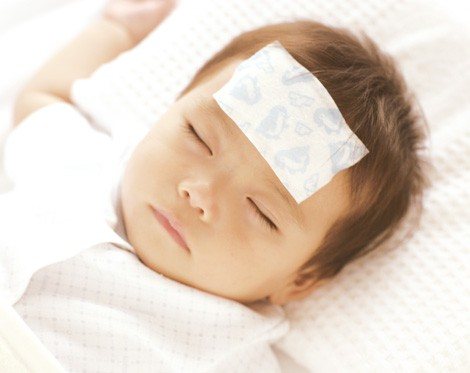
These are the main measures that parents should take immediately after they discover that the child is sick and his thermometer readings are rising. Let's pay attention to the question of how best to lower the temperature.
Medications in the form of syrup
To reduce the temperature at 11 months, a child can use drugs such as Paracetamol, as well as its derivatives: Panadol, Eferalgan, as well as Ibuprofen or Nurofen. The advantage of these drugs is the fact that they are produced in the form of syrup, which has a pleasant taste and smell. Kids willingly use these drugs, as a result of which parents have no problems trying to give the little one medicine.
The main recommendations for the use of antipyretic syrups are as follows:
- the dosage of syrup is prescribed according to the child’s weight, and does not depend on the patient’s age;
- the syrup should be given warm, which will speed up the process of its absorption into the blood;
- exclude repeated use of the antipyretic drug for 4-6 hours;
- If one drug does not give positive results, then you can give another 2 hours later.
The instructions for the medications indicate the required dosage according to the child’s weight. The effect of the syrup is observed 25-30 minutes after taking the syrup.
Antipyretic suppositories for newborns
Candles have a positive reaction after 35-40 minutes, so they take second place in effectiveness. In what cases is it necessary to resort to the use of candles for infants? There are the following factors for this:
- if the baby has a temperature of 39 degrees or higher, then it is necessary to resort to the use of suppositories for the simple reason that with such thermometer readings, absorption from the stomach is suspended;
- if both a month-old and an older child have a fever accompanied by symptoms of vomiting, then there is no point in giving syrup;
- when the syrup does not have an effective effect, which may also be due to poor absorption of the drug from the stomach.
In such situations, the same drugs like Paracetamol and Ibuprofen come to the rescue, only in the form of rectal suppositories. The disadvantage of candles is the fact that placing them on a child is not very convenient or pleasant.
Rubdowns
Wiping children at elevated temperatures with vinegar or alcohol is strictly prohibited. This is due to the fact that these substances can cause severe poisoning. For rubbing, you can resort to using boiled water. This water should be 1 degree lower than the child’s body temperature. Rubdowns are performed as follows:
- prepare gauze or a cloth;
- moisten them and begin wiping the child’s body, starting with the limbs;
- Periodically it is necessary to repeat wetting the fabric in water.
It is important to know! Rubbing can be performed if such manipulations do not cause discomfort in the child.
If your baby has a fever for more than 2-3 days, you should go to the hospital and get diagnosed by a pediatrician
What drugs to give
If a child has a fever, a doctor must come. But while you are waiting for him, be vigilant and act according to the situation. When you noticed that you can’t do without medication, you probably thought about what medications to choose?
How can I safely reduce a fever in a 6-month-old child? The first is the form of the drug. Antipyretics for children come in syrups and suppositories. Tablets should be eliminated immediately, even when ground into powder, they are not designed for the stomachs of babies. Syrups have been created for children. A 6-month-old baby may vomit if the stomach is irritated by drugs. Vomiting increases dehydration, which is already undesirable during a fever. In addition, during illness, the absorption of the stomach and intestines decreases. Consequently, any oral use of drugs may result in the baby “returning” them.
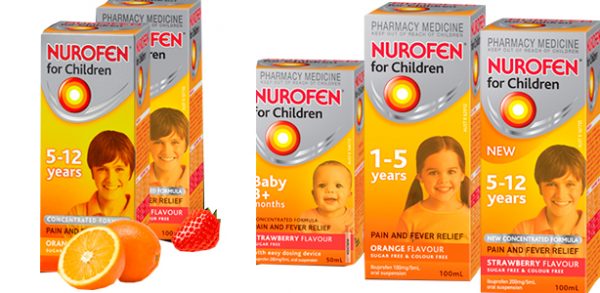
If the temperature is not too high yet, change the spark plugs. Although they act more slowly than syrups in the stomach, they may be the only possible measure when a child is vomiting. And if the baby is not yet 3 months old, then it is generally not advisable to give anything other than candles.
Which active ingredient is best for a child? There are only two of them:
- Ibuprofen;
- Paracetamol.
Panadol, Nurofen, Efferalgan and other drugs are made on their basis. But it is impossible to combine these two active principles at the same time. Be sure to leave a 3-4 hour gap between them.
Children's syrups are all packaged with dispensers, special syringes, or spoons. This makes their use convenient and safe. When calculating the dose, it is important to look not so much at the age of the baby as at its weight. Do not exceed the indicated doses!
Temperature
A single dose of paracetamol can be repeated after 4 hours, the frequency of administration during the day is no more than 4 times. If a child is vomiting, it is better to administer antipyretic suppositories (cefecol, paracetamol).
If the temperature remains high after all the activities, it is necessary to call a doctor at home from the children's clinic, and on weekends and in the evening, call an ambulance. As a rule, in this situation, a lytic mixture is introduced, which includes 50% analgin, 1% diphenhydramine. The lytic mixture is administered intramuscularly, and then oral antipyretic drugs are prescribed.
Prohibited tricks
Pay attention once again to the ban on wrapping up a feverish baby. If the body has already increased heat production, then by undressing and drying your child, you will no longer give him a cold. Dressing and bundling during a fever is a bad idea.
Heat in the room is the big enemy of a child with a fever. The optimal level is 18 degrees Celsius. Ventilation is simply necessary. But not drafts and air conditioners!
Overfeeding is unacceptable. During the course of illness, the stomach significantly reduces its activity. Eating a lot of heavy food will only slow down your recovery. Food should be light.
Aspirin should not be given to children under 12 years of age. The smaller the child, the more dangerous this substance is for him. Liver dysfunction (Reine's syndrome) and cerebral edema may occur due to its use. These are serious conditions that can lead to coma and death.

